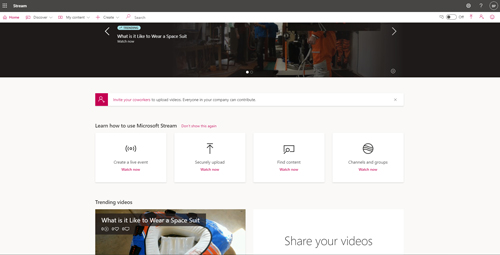Posey's Tips & Tricks
Microsoft Stream Getting a SharePoint-Focused Makeover
Microsoft's plans for its enterprise video streaming platform could greatly improve how organizations manage, store and search through video data.
Stream has long been a part of Microsoft 365 as an enterprise video platform. For those not familiar with Stream, it currently has a lot of similarities to YouTube but is primarily designed for corporate use, rather than for public video hosting. You can see what the Stream interface looks like in Figure 1.
According to Microsoft, the company is re-architecting Stream so that videos are stored in SharePoint. That might not sound all that significant, but it's going to be an important (and very welcome) change for several reasons.
 [Click on image for larger view.] Figure 1: This is what Microsoft Stream looks like.
[Click on image for larger view.] Figure 1: This is what Microsoft Stream looks like.
First, transitioning video storage to SharePoint will result in video files becoming a first-class document type. Of course, some might be quick to point out that Microsoft 365 has supported video content for quite some time and that videos are already a first-class data type. The important takeaway, however, is that moving Stream data into SharePoint will allow video files to be used and managed in the same way as any other type of data that SharePoint supports.
Another reason why Microsoft's announcement is significant is that Stream is not the only place in Microsoft 365 where video data can reside. For example, it's possible to store a video file in OneDrive. What's different this time is that any video that gets uploaded to Microsoft 365 will be considered a Stream video. This holds true regardless of whether the video exists in SharePoint, Yammer, Teams or OneDrive.
The new version of Stream is not available for use yet, so unfortunately I don't have a way of test-driving it. Even so, I think what Microsoft is really going for with its revamp of Stream is breaking down data silos. If all videos (regardless of application) are suddenly considered to be Stream data and are therefore stored in SharePoint, it will presumably become a lot easier to share video data across Microsoft 365 applications.
As great as this may be, there is something else that comes to mind. Over the years, SharePoint has grown into a massively complex and feature-rich application. Early on, however, SharePoint had one feature that really stood out from all of the others: its search engine. As a matter fact, I knew a few early adopters who moved a significant amount of content off of their file servers and into SharePoint solely because SharePoint made it so much easier for users to find the files they were looking for. My guess is that SharePoint's indexing capabilities are eventually going to be leveraged for video data.
Recently, Microsoft has been hard at work on a seemingly unrelated project that could eventually end up benefiting Stream: a recently added a transcription feature in Word on the Web. This feature gives you the ability to upload an audio file to Word and have its contents transcribed. Based on my own testing, this capability seems to work really well (read my full review here).
Microsoft's announcement about the Stream changes briefly mentions video transcription to support things like e-discovery and legal hold. However, my guess is that we will see another use for the video transcription feature. This is something that will likely be far more beneficial to the end user.
Imagine that an organization has a vast collection of videos in its repository and a user needs to locate one specific video. It will be far easier for the user to find what they are looking for if their search can include the video's transcript rather than just the title, description and whatever other metadata happens to exist.
I am also betting that Microsoft will take these improved search capabilities a step further. To show you what I am envisioning, imagine that you are searching a video streaming service like YouTube for a video to walk you through an IT-related task. It might be relatively easy to find the video that you need, but once you find that video, you need to locate the spot in the video with the information you're looking for. After all, you probably don't want to sit through a half-hour introduction to the topic. You would probably prefer to skip ahead to the information that you are really interested in.
If SharePoint is able to transcribe and then index video files, it should be possible for Microsoft to create a search interface that not only helps you find the video that you are interested in, but that also helps you find the most relevant position within the video. Granted, I am speculating as to what Microsoft might do with Stream, but if Microsoft is going to transcribe Stream videos, then it makes sense to index them, as well.
About the Author
Brien Posey is a 22-time Microsoft MVP with decades of IT experience. As a freelance writer, Posey has written thousands of articles and contributed to several dozen books on a wide variety of IT topics. Prior to going freelance, Posey was a CIO for a national chain of hospitals and health care facilities. He has also served as a network administrator for some of the country's largest insurance companies and for the Department of Defense at Fort Knox. In addition to his continued work in IT, Posey has spent the last several years actively training as a commercial scientist-astronaut candidate in preparation to fly on a mission to study polar mesospheric clouds from space. You can follow his spaceflight training on his Web site.